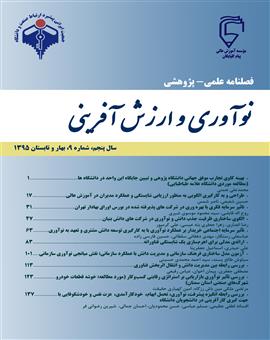ارائهی مدلی برای اهرمسازی یک شایستگی فناورانه (مورد مطالعه: ربات مارسان)
محورهای موضوعی :علی حیدری 1 , اسماعیل جعفر پناه 2
1 - دانشکده مدیریت دانشگاه تهران
2 - دانشگاه تهران
کلید واژه: مسیر/فرآیند اهرمسازی شایستگی فناورانه, محصولات با فناوری پیشرفته, تصمیمگیری چند معیارهی فازی, ربات مارسان,
چکیده مقاله :
یکی از مهمترین توانمندیهای پویای بنگاههای فناوریمحور عصر حاضر، اهرمسازی یک دستاورد فناورانه برای ابداع کاربردها و محصولات جدید -و به تبع آن بازارهای جدید- است. پژوهش حاضر شایستگی فناورانهی ربات مارسان را مورد مطالعه قرار داده و هدف اصلی آن تعیین نقطهی آغاز فرآیند/مسیر اهرمسازی این شایستگی است. برای این منظور ابتدا بازارهای هدف موجود برای اهرمسازی این شایستگی شناسائی و سپس با استفاده از یک مدل تصمیمگیری چندمعیاره با رویکرد ترکیبی ANP-DEAMATEL و TOPSIS در محیط فازی، رتبهبندی شدهاند. خبرگان پژوهش از میان متخصصان شرکتهای صنعتی و دانشبنیان و اعضای انجمنهای علمی مرتبط با شایستگی مورد نظر انتخاب شدهاند. نتایج مدل تصمیمگیری چندمعیاره بر اساس دادههای حاصل از نظرات خبرگان نشان میدهد، صنعت نفت بیشترین جذابیت را برای شروع اهرمسازی ربات مارسان داراست. از مدل ارائه شده در این پژوهش میتوان با جرح و تعدیلاتی برای سایر محصولات با فناوری پیشرفته نیز استفاده نمود.
Nowadays, one of the most important dynamic capabilities of technology-intensive firms is leveraging of technological achievements for the creation of new applications and products and as a result, the new markets. This research studied the snake-like robot technological competence and its main purpose is to determine the starting point for leveraging process/path of this competence. For this purpose, available target markets for leveraging this competence have been identified and then have been ranked with performing multi-attributes decision making through ANP-DEAMATEL and TOPSIS hybrid model in fuzzy environment. Research experts have been selected from industrial knowledge intensive firms and scientific associations related to this competence. Multi-attribute decision making model results, based on data from experts, show that oil industry has the most attractiveness for starting of snake-like robot leveraging. The model presented in this research, with some modifications and adjustments can also be used for other high-technology products.
Barney, J. (1991). Firm resources and sustained competitive advantage. Journal of management, 17(1), 99-120.
Danneels, E. (2002). The dynamics of product innovation and firm competences. Strategic management journal, 23(12), 1095-1121.
Danneels, E. (2007). The process of technological competence leveraging.Strategic Management Journal, 28(5), 511-533.
Drejer, A. 2001. How we define and understand competencies. Technovation 21, no. 3: 135–46.
Guptat, U. (2010). Insight into firm’s strategy for leveraging technological competences in Asia. Journal of intellectual Property Rights, 15, 130-137.
Hamel, G., & Heene, A. (1994). Competence-based competition. Wiley.
Hopkins, J.K., Spranklin, B.W., Gupta, S.K., (2009). A survey of snake-inspired robot designs, Bionispiration and Biomimetics, 4(2).
Huang, K. F. (2011). Technology competencies in competitive environment. Journal of Business Research, 64(2), 172-179.
Huynh, V.N. & Nakamori, Y. (2009). A linguistic screening evaluation model in new product development, IEEE Transactions on Engineering Management, 56 (4): 1-11.
Lee Amy H.I., Wen-Chin Chen, Ching-Jan, Chang (2008). A fuzzy AHP and BSC approach for evaluating performance of IT department in the manufacturing industry in Taiwan, Expert Systems with Applications, 34 (1): 96–107.
Lee, J.R., and J.S. Chen. (2000). Dynamic synergy creation with multiple business activities: Toward a competence-based growth model for contract manufacturers. In Research in competence-based management, ed. R. Sanchez and A. Heene, 209–28. London : Elsevier.
Liu, H. Y., & Liu, F. H. (2011). The process of competence leveraging in related diversification: a case of technology management at a composite-material company. Technology Analysis & Strategic Management, 23(2), 193-211.
Markides, C.C., and P.J.Williamson. (1994). Related diversification, core competences and corporate performance. Strategic Management Journal, 15 (special issue): 149–65.
McEvily, S. K., Eisenhardt, K. M., & Prescott, J. E. (2004). The global acquisition, leverage, and protection of technological competencies. Strategic Management Journal, 25(8‐9), 713-722.
Mohanty, R.P., Agarwal, R., Choudhury, A.K. and Tiwari, M. (2005). A fuzzy ANP-based approach to R&D project selection: a case study, International Journal of Production Research, 43 (24): 5199-216.
Prahalad, C. K., & Hamel, G. (2006). The core competence of the corporation (pp. 275-292). Springer Berlin Heidelberg.
S.L. Chan and W.H. Ip (2010). A Scorecard-Markov model for new product screening decisions, journal of Industrial Management & Data Systems, 110 (7): 971-992.
S.L. Chan, W.H. Ip, C.K. Kwong (2011). “Closing the loop between design and market for new product idea screening decisions”, Expert Systems with Applications,Vol 38, p. 7729–7737.
Teece, D. J., Pisano, G., & Shuen, A. (1997). Dynamic capabilities and strategic management. Strategic management journal, 18(7), 509-533.
Teece, D.J., R. Rumelt, G. Dosi, and S.G.Winter. (1994). Understanding corporate coherence – theory and evidence. Journal of Economic Behavior and Organization, 23, no. 1: 1–30.
Tseng, M. (2009). “Using the extension of DEMATEL to integrate hotel service quality perceptions into a cause–effect model in uncertainty.” Expert Systems with Applications, 36(5), PP. 9015-9023.
Wang, Ray,. Shu-Li, Hsu, Yuan Hsu Lin, Ming-Lang Tseng (2011). Evaluation of customer perceptions on airline service quality in uncertainty, Procedia - Social and Behavioral Sciences, 25: 419-437.
Xiaojun Wang, Hing Kai Chan , Dong Li (2015). “A case study of an integrated fuzzy methodology for green product development”, European Journal of Operational Research , Vol. 241 , p. 212–223.
Xu, L., Li, Z.B., Li, S.C. and Tang, F.M. (2007). A decision support system for product design in concurrent engineering, Decision Support Systems, 42 (4): 2029-42.
Wang, Y., & Lo, H. P. (2003). Customer-focused performance and the dynamic model for competence building and leveraging: A resource-based view. Journal of Management Development, 22(6), 483-526.


